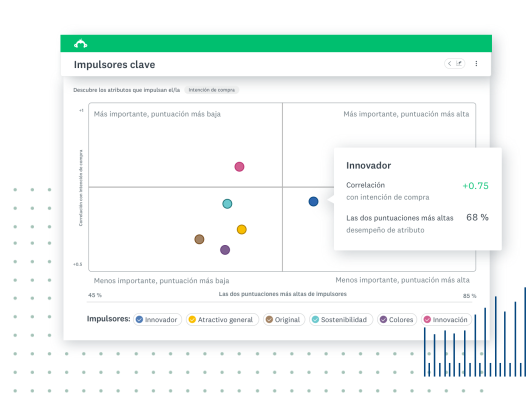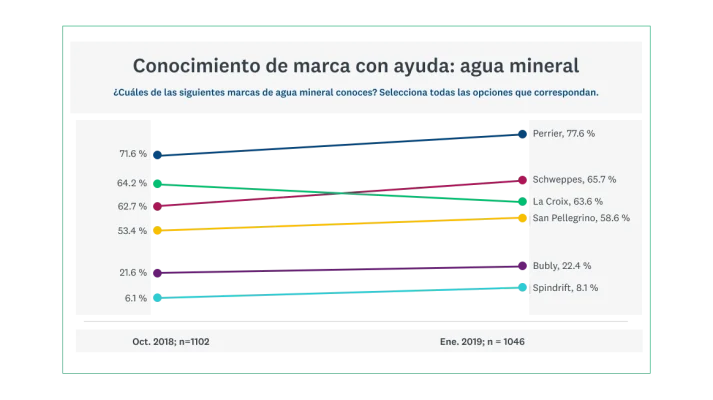More Resources
¿Qué es un estudio de usos y actitudes?
Un estudio de usos y actitudes (U&A) (conocido también como estudio de actitudes y usos, o estudio de A&U) es un estudio popular basado en encuestas que se utiliza en investigaciones de mercado para ayudarte a entender a fondo tu mercado, identificar quiénes, desde dónde y con qué frecuencia compran, así como qué productos prefieren, y a explorar la relación entre opiniones/actitudes y hábitos de consumo. Te ayuda a encontrar las respuestas a preguntas comunes como:
- ¿Para qué se utiliza exactamente mi producto o marca?
- ¿Los diferentes tipos de clientes utilizan mi producto o marca de maneras distintas?
- ¿Existen diversos patrones de uso típico de mi producto?
- ¿Ciertos segmentos de consumidores utilizan mi producto con mayor o menor frecuencia?
- ¿Los clientes usan únicamente mi producto o también utilizan productos de la competencia? ¿Cuáles?
Para responder estas preguntas, se puede realizar uno de los cuatro tipos principales de estudios de U&A. El enfoque exacto dependerá de tus necesidades. Puedes optar por una o combinar varias de las siguientes estrategias:
- Enfoque de comprensión de categorías: El objetivo de este tipo de estudio de U&A es conocer más sobre las características del mercado en su conjunto. Por ejemplo, si vendes ropa por Internet, quizás te interese saber más sobre las características del típico comprador de moda online: cuándo compra, con qué frecuencia lo hace y a través de qué medio lo hace (dispositivo móvil, tablet o computadora portátil).
- Enfoque para dimensionar el mercado: Este tipo de investigación de U&A se centra en medir el nivel de presencia de varias categorías de productos en el mercado, así como la frecuencia de uso o consumo. Por ejemplo, incluso si vendes una amplia gama de ropa en tu tienda en línea, puede darse el caso de que los compradores online prefieran comprar ciertas categorías de productos (como ropa interior) en una tienda física, donde pueden probarse las prendas o tener una mejor idea de cómo se siente la tela. Este tipo de conocimiento puede ayudarte con todo tipo de decisiones de marketing, como qué productos almacenar, cuáles promocionar y a quiénes dirigirlos.
- Enfoque de comprensión de la marca: Puedes emplear la investigación de usos y actitudes para conocer aspectos como la penetración de la marca, la percepción del público, el valor de la marca y los factores que impulsan su elección. Todos estos son elementos clave para desarrollar una estrategia competitiva.
- Enfoque de focalización: Un estudio de usos y actitudes también puede proporcionar información crucial para segmentar a los clientes según sus actitudes y comportamientos, lo cual te ayuda a enfocar mejor tus mensajes y estrategias de segmentación.
¿Qué tan bien conoces a tu mercado objetivo?
Identifica las motivaciones y necesidades de tus usuarios con nuestra solución para estudios de usos y actitudes.
Cuándo realizar un estudio de U&A
Una de las principales ventajas de un estudio de usos y actitudes es que es muy versátil y puede usarse en una variedad de aplicaciones diferentes. En particular, deberías considerar realizar un estudio de U&A si tienes alguna de las siguientes necesidades:
- Quieres comprender mejor los deseos y los puntos problemáticos de los clientes.
- Crees que podrías estar perdiendo oportunidades para impulsar el consumo o uso adicional de tus productos.
- Estás a punto de desarrollar nuevas categorías de productos o estrategias de marketing.
- Quieres desarrollar una mayor comprensión del panorama general de la competencia.
Objetivos de un estudio de usos y actitudes
Observar las últimas tendencias en el comportamiento de los compradores que impulsan la dinámica del mercado en tu industria
Los compradores cambian constantemente su forma de pensar acerca de los productos y servicios, y esto tiene implicaciones en su comportamiento de compra. Sus cambios de actitudes y usos no solo están determinados por la forma en que interactúas con ellos (por ejemplo, a través de tus campañas de marketing), sino también por las acciones de tus competidores, así como por cambios más amplios en el entorno del mercado. La pandemia de COVID-19 es un gran ejemplo: los productores de bebidas alcohólicas descubrieron que no solo aumentaron las ventas de vino y licores para consumir en casa, sino que el gasto promedio por consumidor también aumentó. Cuando los patrones de consumo cambian así, o la industria sufre una disrupción o sacudida, es momento de evaluar los usos y las actitudes de los consumidores para tomar decisiones mejor fundamentadas.
Obtener una comprensión más profunda de tus compradores y su comportamiento para impulsar la adopción y las compras de tus productos o servicios
Una vez que el cliente se lleva tu producto a casa, la venta terminó, ¿verdad? Bueno, no tanto.
A veces, al enfocarnos en el lado de la oferta del negocio (la venta), nos olvidamos de pensar cómo encajan nuestros productos en la vida cotidiana del cliente una vez que salen de la tienda. Sin embargo, comprender el uso que hacen los clientes a un nivel más profundo puede ayudar a garantizar que tu producto se adapte perfectamente a ellos y que se satisfagan sus necesidades adicionales, lo cual a su vez puede impulsar las ventas futuras. Por ejemplo, digamos que tu producto principal es una máquina elíptica para uso doméstico. Dedicar tiempo para aprender sobre las interacciones de los clientes con ella, como en qué habitación la guardan, con qué frecuencia la utilizan y cómo se turnan los miembros de la familia para usarla, puede brindar percepciones profundas que te ayuden dirigir el desarrollo futuro de productos y a enfocar mejor tus campañas de marketing. Por ejemplo, podrías descubrir que los miembros más jóvenes de la familia quieren usar la máquina, pero su tamaño no es adecuado para niños. Esto podría llevarte a desarrollar equipos de entrenamiento pensados específicamente para ellos.
Medir la demanda de tus productos para perfeccionar tus ofertas en cada paso del proceso de desarrollo: conceptualización, desarrollo, comercialización y repetición
Otro objetivo de los estudios U&A es medir la demanda de tus productos entre los consumidores de tu público objetivo, lo cual te permite refinar tu posicionamiento y oferta, y estar mejor preparado para impulsar las ventas. Por ejemplo, imagina que eres un vendedor de tapetes para yoga, pero quieres ampliar tu mercado para llegar a los principiantes. Según los resultados de un estudio de U&A que evalúa la demanda general de yoga, así como dónde se utilizan los tapetes para yoga (por ejemplo, en casa o en un estudio) y cómo (los tipos de estiramientos que realizan), es posible que puedas desarrollar un tapete ilustrado que muestre a los principiantes dónde colocar los pies para ciertas posturas populares; en otras palabras, crear un producto innovador que satisfaga mejor las necesidades de tus clientes y genere interés en tu marca.

Orientar estrategias futuras
Si te estás preparando para un cambio significativo, como lanzar una nueva gama de productos, invertir en una gran campaña publicitaria, ampliar la marca o ingresar a un nuevo mercado, un estudio de usos y actitudes es absolutamente vital. Es imposible tener la certeza de que el salto será exitoso a menos que tengas un conocimiento profundo y actualizado sobre tu base de clientes, los patrones de uso y sus actitudes hacia tu marca y las demás. Con un estudio de U&A, puedes aclarar estas dudas y de esta forma definir y optimizar tus estrategias.
En general, realizar un estudio de investigación de U&A puede ayudarte a identificar oportunidades para expandir y hacer crecer tu negocio a través de una estrategia optimizada de marca y producto. Veamos cómo implementalo.
Metodología de un estudio de usos y actitudes
Existen diferentes formas de realizar un estudio de usos y actitudes. Sin embargo, una de las más eficaces sigue el modelo tradicional de embudo de conversión de ventas. Este modelo comienza por obtener una comprensión más amplia de tu mercado y se centra en la forma específica en que los clientes interactúan o perciben tu marca. Echemos un vistazo a cada paso.
Paso 1: Obtén una muestra adecuada
Aunque los datos de los estudios de U&A pueden ser sumamente valiosos, muchas empresas fallan desde el inicio al intentar utilizarlos porque no obtienen una muestra adecuada. Es fundamental que la muestra de la que recopiles tus datos sea genuinamente representativa de tu base de clientes. Por ejemplo, si tu muestra está sesgada hacia un público mayor que prefiere las compras en tiendas físicas a las compras en línea, es poco probable que la evaluación de las actitudes y comportamientos de tu mercado sea válida. En lugar de eso, necesitarás calibrar a tu público para que refleje a tus clientes en términos demográficos, psicográficos y de comportamiento. Si no sabes cómo encontrar una muestra como esta, tenemos un público ya preparado que se puede seleccionar en función de aspectos como sexo, ingresos, empleo y mucho más.

Población general (muestra mediana)
- Todos los sexos (censo)
- Todas las edades (censo completo)
- Todos los ingresos
- 500 respuestas, Latinoamérica - SurveyMonkey

Empleados de tiempo completo
- Todos los sexos (censo)
- Todas las edades (censo básico)
- Todos los ingresos
- Empleo de tiempo completo
- 250 respuestas, Latinoamérica - SurveyMonkey

Compradores consumidores
- Todos los sexos (censo)
- Todas las edades (censo básico)
- Todos los ingresos
- Persona que toma las decisiones en el hogar
- 250 respuestas, Latinoamérica - SurveyMonkey
Paso 2: Utiliza la memoria espontánea para establecer un punto de partida
Así como un estudio de U&A a menudo se utiliza para establecer las bases con el fin de fundamentar futuras decisiones de marketing, la primera parte de una encuesta de usos y actitudes puede ayudarte a establecer un punto de referencia para futuras investigaciones. Si pides a los encuestados que nombren, sin ayuda, las marcas o productos que les vienen a la mente en una categoría específica, obtendrás una idea sólida del conocimiento que tienen de tu marca en comparación con la de la competencia, así como de la eficacia de cualquier campaña de marketing reciente.
Paso 3: Evalúa las actitudes y los usos de marcas específicas
A continuación, utiliza la encuesta para explorar las actitudes de los clientes y el uso de productos o marcas específicos. La memoria espontánea es una excelente forma de lograrlo. Por ejemplo, puedes enumerar una serie de marcas de la competencia y luego pedir a los encuestados que indiquen cuáles conocen, cuáles utilizan actualmente y cuáles han considerado utilizar.

Paso 4: Profundiza en los detalles
Una vez que hayas preguntado sobre el conocimiento y el uso de la marca, es hora de explorar más a fondo la percepción de los clientes sobre tu marca, y quizás también de las de tus competidores. Por ejemplo, imagina que abriste una tienda de ropa de primera calidad en línea. ¿Los clientes realmente perciben tu marca como premium o hay tiendas de la competencia que se consideran aún más prestigiosas? Al preguntar sobre la percepción de tu posicionamiento, puedes entender cómo se ubica tu marca en el mercado actual y qué tan fuerte es frente a la competencia.
Preguntas de una encuesta de usos y actitudes
Puntos problemáticos, necesidades y deseos
Ya sea que estés vendiendo un producto o servicio existente a un mercado conocido o desarrollando una nueva oferta de producto, es fundamental tener claro el perfil de tu consumidor objetivo. Realizar una encuesta de U&A para captar las necesidades, los deseos y los puntos problemáticos de los clientes te ayudará a comprender, en un nivel más profundo, quiénes son tus clientes, qué quieren y por qué compran. Para obtener este tipo de información puedes utilizar preguntas cerradas o abiertas. Por ejemplo, si decides hacer preguntas abiertas, podrías preguntar:
- ¿Qué es lo más frustrante de comprar ropa en línea?
- ¿Qué te impide comprar ropa en línea?
O bien, puedes hacer preguntas cerradas como:
- Si tuvieras un presupuesto ilimitado, ¿gastarías más en ropa por Internet o en la tienda? [en línea/en una tienda física]
- Cuando compras ropa en línea, ¿cuál de los siguientes factores es el más importante para ti? [el precio/cómo me queda/la calidad/la ética comercial/la marca]
Haz las preguntas que siempre has querido hacer
Obtén una comprensión profunda de lo que quiere tu mercado objetivo con la solución para estudios de usos y actitudes de SurveyMonkey.
Actitudes y usos de tu marca o producto
Como sugiere el nombre, las preguntas de una encuesta de investigación de U&A deben enfocarse en conocer más sobre las actitudes y el comportamiento de los consumidores a lo largo de la trayectoria del cliente. Eso implica centrarse en la percepción sobre los productos, cómo se sienten los clientes acerca de tu oferta actual y cómo utilizan tus productos en su vida cotidiana. Por ejemplo, considera una pregunta tan simple como:
- ¿Con qué frecuencia compras ropa nueva en línea?
Las respuestas a esta pregunta por sí solas pueden ayudarte a segmentar tu mercado en función del comportamiento de consumo. Es posible que descubras que tienes tres mercados: los que compran en línea con poca frecuencia, los que nunca compran en línea y los que compran en línea todos los días. Analizar estas respuestas junto con las de preguntas sobre las experiencias de los consumidores al comprar en línea, o sus actitudes hacia las compras por Internet en general, te dará una visión profunda que puede ayudarte a garantizar que se atiendan las necesidades específicas de cada segmento, que los nuevos productos o servicios se dirijan a los segmentos correctos y que tus clientes estén satisfechos una y otra vez.
Actitudes hacia tus rivales
Un estudio de la U&A no se trata solo de evaluar las actitudes de los consumidores hacia tu propia marca y categorías de productos. Las preguntas comparativas pueden brindar percepciones valiosas sobre tu posicionamiento en relación con tus competidores. Por ejemplo, puedes presentar a los encuestados una lista de productos y marcas de la competencia y pedirles que los clasifiquen desde sus favoritos hasta los que menos prefieren. Otra alternativa es hacer preguntas específicas sobre los atributos relativos de distintos productos dentro de una misma categoría, por ejemplo:
- ¿Cuál de las siguientes marcas crees que es de mejor calidad?
- ¿Cuál de las siguientes marcas crees que es la más confiable?
- ¿Cuál de las siguientes marcas crees que es la más ética?
Hábitos de compra y consumo
Las preguntas relacionadas con los comportamientos de compra y consumo son cruciales para desarrollar las estrategias de promoción, posicionamiento y distribución adecuadas que sabemos que impulsan las ventas. Los tipos de preguntas que son útiles aquí incluyen:
- Preguntas sobre los tipos de tiendas que visitan tus encuestados
- Preguntas sobre los factores desencadenantes que les llevan a realizar compras
- Preguntas sobre las barreras que perciben para comprar
- Preguntas sobre su lealtad hacia tu marca y hacia cualquier competidor
Consejos para crear un estudio de usos y actitudes
Los estudios de U&A son muy valiosos para brindar a las empresas una base sólida de entendimiento de su mercado y sus clientes. Sin embargo, una encuesta de U&A mal diseñada puede socavar la aplicabilidad de los resultados. Sigue estos consejos para asegurarte de que tu encuesta de U&A te brinde percepciones con las que puedas actuar:
- Establece un objetivo para la encuesta. Es fundamental tener una comprensión clara de cómo se utilizarán los datos una vez que los haya recopilado.
- Crea una encuesta interactiva y atractiva. A veces, a los encuestados les resulta difícil recordar o describir cómo utilizan los productos en su vida diaria. Incorpora recursos visuales, como imágenes de tu producto o un video de tu servicio, para ilustrar la idea y estimular respuestas válidas y útiles.
- No trates de incluir demasiado. Las encuestas largas y aburridas donde se busca capturar todo de una sola vez casi nunca te proporcionan los resultados que necesitas. Si tienes dificultades para limitar tu encuesta a las preguntas que realmente importan, uno de nuestros expertos puede ayudarte.
Entonces, en resumen, utiliza un estudio de investigación de usos y actitudes para entender qué tan atractivos resultan tus productos y servicios para los clientes y para identificar futuras oportunidades de mercado mediante la exploración de los hábitos de compra, percepción y uso de los clientes. ¿Quieres comenzar ya?
Comienza tu investigación de mercado
Panel mundial de encuestas
Envía tu encuesta a una muestra representativa y recopila datos de investigación de mercado
Servicios de investigación
Trabaja con nuestro equipo de expertos en investigación de mercado y recibe ayuda con tu proyecto
Soluciones de expertos
Pon a prueba el material creativo o los conceptos de producto con un enfoque automatizado de análisis e informes
